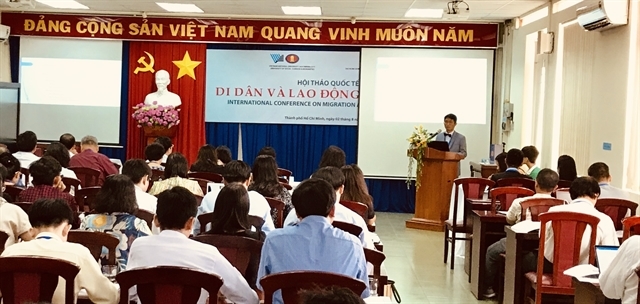 |
| Kaxton Yu-Kwan Siu, of the Hong Kong Polytechnic University’s Department of Applied Social Sciences, speaks at the “Migration and Labour in Việt Nam” international conference yesterday in HCM City. |
Labour migration is a highly fluid phenomenon in the 21st century, capturing public attention and driving political controversy globally, Prof Kaxton Yu-Kwan Siu, of the Hong Kong Polytechnic University’s Department of Applied Social Sciences, said.
“There are more and more labour migrants working in areas beyond their birth country or region than ever before,” he said. “Although scattered across the social ladder, migrant workers have always clustered, at least initially, in the bottom rungs of the working class.”
“Even as cross-border or inter-regional movement may beckon as a source of hope and new opportunity, the experience for migrants and their families is often fraught with peril,” he added.
In Việt Nam, foreign investors, for example, had built many export-oriented factories that had generated a constant rural-to-urban work migration flow, Siu said.
Nguyễn Thị Hồng Xoan, dean of the sociology faculty at the University of Social Sciences and Humanities in HCM City, said that migrant workers faced a lack of protections, high recruitment costs, and costly and lengthy migration procedures.
In 2015, some 36 per cent of HCM City’s population were migrants with temporary residence status, according to figures from the World Bank.
Another survey by the World Bank in the same year showed three quarters of employees at foreign firms in Việt Nam were migrant workers.
Around 80,000 Vietnamese leave the country for jobs overseas each year, according to the International Labour Organisation (ILO). About 400,000 Vietnamese workers are present in more than 40 countries and territories worldwide.
According to the World Bank’s Migration and Remittances, the inflows of remittances to Việt Nam by guest workers reached $13.8 billion in 2017, a rise of 16 per cent over 2016, ranking eighth in the world, showing the economic significance of labour migration.
However, there are major issues associated with labour migration such as the violation of rights of workers by employers, breach of contracts and desertion by workers, illegal networks of recruitment, and violation of government regulations on recruitment procedures.
Migrant workers are often vulnerable and policies across the region do little to address their needs, according to the ILO.
According to UN data, 80 per cent of intra-ASEAN migrants are low skilled and many of them are undocumented.
Construction, plantation work and domestic services are the sectors that receive the most migrant workers.
They often face arrest or deportation when attempting to fight for their rights, and are bound to special documents that limit their ability to change jobs.
The conference on “Migration and Labour in Việt Nam” gathered scholars from different parts of the world and drew on a wide variety of disciplines, including history, anthropology, ethnic studies, gender studies, public health, law and public policy.
The event aimed to generate new research agendas and propose policies that can improve conditions for migrants.
The event was organised by HCM City’s University of Social Sciences and Humanities and Hong Kong Polytechnic University. — VNS
 Improved international regulations and standards to protect the rights and welfare of migrants, including thousands of Vietnamese guest workers, are needed in today’s globalised world.
Improved international regulations and standards to protect the rights and welfare of migrants, including thousands of Vietnamese guest workers, are needed in today’s globalised world.